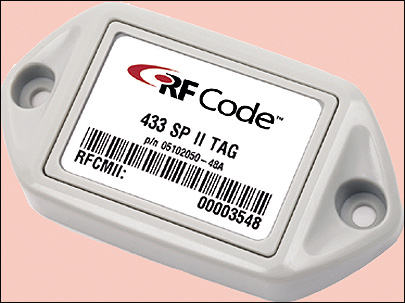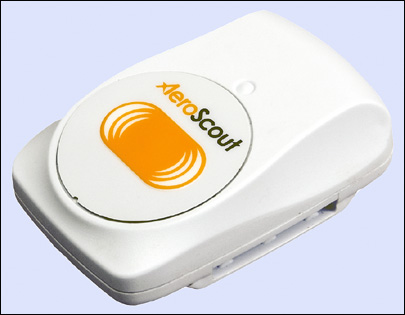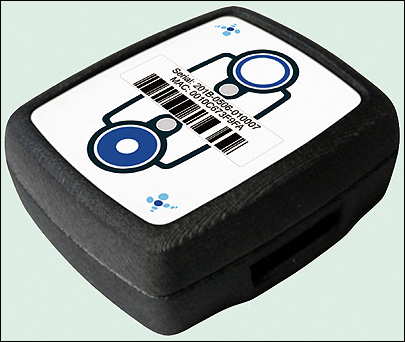Dec 01, 2006One of the key benefits of radio frequency identification technology is that it can enable organizations to locate specific objects in a given area at a particular moment in time. Real-time locating systems (RTLSs) leverage RFID to provide this capability by using radio signals to transmit the physical location of tagged objects in real or near-real time. RTLSs are being adopted in industries such as health care, logistics and manufacturing, as companies realize the benefits of having an automated way to track the location of assets—and, in some cases, people—in real time. The U.S. military uses RTLSs to monitor the movement of trucks as they enter and leave terminals.
Major components of the automated systems include RFID tags—typically, active (battery-powered) tags, but recently some passive ones—that are attached to the objects being tracked; RFID interrogators (also called receivers or activators) located throughout a particular area—such as a warehouse, distribution yard or hospital—to identify the location of the object; and software that provides the tracking application. Proponents of RTLSs say the technology offers certain advantages over other locating systems, such as infrared, bar-code and global-positioning systems. For example, RTLSs can require less maintenance than infrared and don't need line-of-sight readings as do bar-code systems.
While RTLSs have been around for more than a decade, standards for systems interoperability are still emerging. That can make it difficult for organizations to share information along the supply chain. Managers considering an RTLS for a supply-chain application, such as global shipments received at a distribution center, might want to look into hardware that supports multiple frequencies and protocols.
Two key industry standards relate to RTLSs, according to Steve Halliday, founder of High Tech Aid, a consulting firm specializing in automatic identification and data collection. ANSI INCITS 371, published by the American National Standards Institute, covers air-interface protocols and application programming interfaces. It is intended to encourage interoperability of products from various RTLS vendors. ISO 24730, from the International Organization for Standardization, covers air-interface protocols and location algorithms for RTLS. It is expected to be published soon.
Another issue is the cost of RTLS tags. They're expensive, so tracking low-value assets is usually not an option. One interrogator can range from less than $500 to thousands of dollars. A company wouldn't need many to cover a large open area such as a distribution yard, but numerous units would be required to cover a building that has many corridors and rooms.
Despite the challenges, the global market for RTLSs is expected to increase from about $245 million in annual sales in 2006 to $1.26 billion by 2011, a 30 percent compound annual growth rate, according to research and consulting firm Frost & Sullivan. As shown in this chart (click here to download it), which offers details on more than a dozen RTLS providers, choosing an RTLS that's right for your company can be confusing. Here are some of the important factors to consider to help you narrow down your choices and make a smart decision.
RTLS products work in different ways, using a variety of active tags and methods to calculate location. Some systems use beacon tags, which are set to broadcast a signal every few seconds or minutes. Typically, the user can define the interval based on whether the priority is to conserve battery power or to gain greater visibility into the moment-to-moment movement of the asset. Having the beacon broadcast every few seconds provides greater visibility into the movement of goods but shortens battery life.
Most RTLSs use triangulation to determine the location of assets. The time that it takes for a signal to reach the interrogator is used to determine the location of an object. This type of system can accurately calculate location to within 10 feet.
In some systems, tagged assets can be assigned to tagged, authorized personnel; software can track who moved a particular item and whether that movement is authorized, and can send out alerts to recover an asset before it leaves the premises. Some RTLSs operate with antennas that are hidden under floors or above ceiling tiles, so they're not easy for potential thieves to locate and circumvent. The use of covert antennas can also help maintain aesthetics in a building.
Some vendors sell multiple RTLS products to suit different needs. For instance, one system from Identec Solutions uses beacon-tag architecture and is designed for applications that don't require precise location or visualization of particular assets, and in which the assets are not fast-moving. Identec also offers a response-tag architecture, which enables the location of one specific item among many items. It's particularly suited for tracking and managing finished goods and assets, such as containers, in certain manufacturing industries—agriculture, aircraft, automotive, heavy equipment and others.
Some systems provide an especially high level of location accuracy. Parelec's iLocate RTLS can locate objects down to 1 foot where line-of-sight is available. The tag switches to an "optical location mode" and performs a high-accuracy location procedure. The signal is received by optical readers mounted above the monitored area and processed by an iLocate server.
Some RTLS products capture data using location-aware mobile interrogators rather than fixed interrogators. This type of system can be more cost-effective than a fixed system, as the interrogators can be moved within a space as needed.
Companies with varying needs for tracking might want to consider a versatile RTLS. For example, RF Code's RTLS platform can be configured to locate assets using four distinct approaches, depending on what's most appropriate in an environment: zonal tracking; a mobile (handheld) option; infrared tracking, which defines asset tags that enter individual rooms; and algorithmic tracking, which provides the highest resolution by using multiple interrogators to calculate the exact location of an object.
Some vendors have tailored their systems for particular industries, with software designed to support applications or facilities common to those sectors. A WhereNet system designed for a shipping company, for instance, comes with software designed specifically for marine-terminal applications.
Axcess International, another vendor, has years of experience developing software for the security industry. The primary application for its RTLS is linking people to assets for asset management and control.
Parco Merged Media offers a product under the Precis brand name, designed for the health-care industry: Its Hospital Grade Wireless systems were developed for reliability, electromagnetic compatibility and data exchange in hospitals.
What Type of Tag Does the System Use?
The majority of RTLS offerings employ longer-range active RFID tags, but a growing number of systems use passive tags to locate objects. Passive tags, which generally cost considerably less than active tags, can be used when long-range coverage isn't required. Some of the RTLSs that use passive tags include mobile interrogators that can be moved around a space such as a warehouse.
Some systems use both active and passive tags. PanGo Networks' product, called PanOS Platform, includes active RFID tags that operate at a frequency of 2.4 GHz and can report location and status in either Wi-Fi or beacon mode. PanOS can also collect location data from sources such as passive RFID "choke" points, allowing a company to choose the appropriate mix of active and passive location technologies based on its needs.
The life span of active tags can be an important consideration when exploring systems. How long will the tags operate before needing to be replaced, and how practical will it be to replace tags frequently? Some active tags have a battery life of up to seven years, while others can be expected to last just over four years.
Another tag-related factor is the frequency of the signal. Do the tags transmit a low-frequency signal for shorter-range applications, or at a higher frequency to transmit the signal to long-range receivers? Parco says its "hybrid" tag will work across multiple frequencies.
Companies might also want to consider whether the tags provide capabilities such as on-board motion and temperature sensors, to transmit information in addition to location. For example, the tags included in the RTLS offering from PanGo have a motion-detection feature that enables them to send motion alerts, and allows for different transmission rates depending on whether an object is stationary, in motion or in transition from in-motion to stationary.
What Size Area Do You Need to Cover?
RTLSs can track the location of objects within relatively small areas or over massive amounts of space. One important issue is how much area you need to cover when tracking objects.
Some systems offer varying coverage. For instance, Axcess's ActiveTag RTLS enables users to adjust the power output on the system's Activator transmitter to expand or reduce the activation area, creating control points ranging from a few feet in diameter to tens of feet across.
Some systems, such as the suite of products from AeroScout, are designed to work equally well in indoor and outdoor environments. Others are intended for either indoor or outdoor use. Outdoor systems must be able to function well despite variations in climate or temperature. It's also important to consider whether the RTLS technology can operate well in more challenging environments, such as those in which many vehicles move around, or where a significant quantity of metal could affect the quality of signal transmission.
WhereNet says its RTLS has low sensitivity to water and metal. The system uses time difference of arrival—the same methodology used in GPSs—to calculate location, in combination with wideband technology, to provide optimum performance in harsh or industrial environments.
Does the RTLS Fit With Existing Systems?
The ease with which an RTLS can be integrated with existing enterprise applications—such as supply-chain and asset-management software—can be another important factor in selecting a system. If the RLTS vendor offers a system that has an open, standards-based architecture, that could make the integration process much easier.
Some vendors that specialize in certain industries offer tools to help integrate their RTLS products with applications commonly used in those industries. For example, Parco offers software to fully integrate its system with applications now being used in many U.S. hospitals.
Is the System Wi-Fi–Compatible?
A number of RTLS products support the 802.11 wireless LAN communications standard for what are commonly known as Wi-Fi networks. The tags communicate with the Wi-Fi network. This can be important if an organization currently has or is planning to deploy such a network.
Ekahau says its RTLS is fully compatible with all 802.11 networks, regardless of vendor, and that its system requires no additional hardware beyond that used in the customer's existing Wi-Fi network.
When choosing a system that will run on a Wi-Fi network, consider bandwidth usage. Some systems are designed for very low use of Wi-Fi or Ethernet backbone network resources, so interference with other network traffic is minimized.
Is the Price Right?
RTLS packages can be expensive. The cost of tags alone can range from $10 for basic products to $200 for more sophisticated tags that include sensors. Interrogator prices can also vary widely, with some costing less than $500 and others priced in the thousands of dollars. Depending on the size of the implementation and the number of tags needed, an RTLS implementation can cost well under $100,000 or more than $2 million.
Some vendors price their systems based on the specific implementation. For instance, RF Code's RTLS products are priced on a per-customer basis. The tags are available for less than $10 in high volumes, but the total cost of an RTLS deployment is based on the operating environment and the architecture needed by the customer.
Another cost that must be factored in is yearly support and maintenance expenses. When evaluating products, ask vendors how much it will cost to keep their software and hardware operating effectively.
Finally, any company interested in deploying an RTLS should think about its future needs. The scalability of the system is critical if a company plans to expand the use of its RTLS over time. Some systems are designed to track hundreds of objects, others thousands, and still others can be expanded depending on the customer's needs.
Illustration by William Rieser




